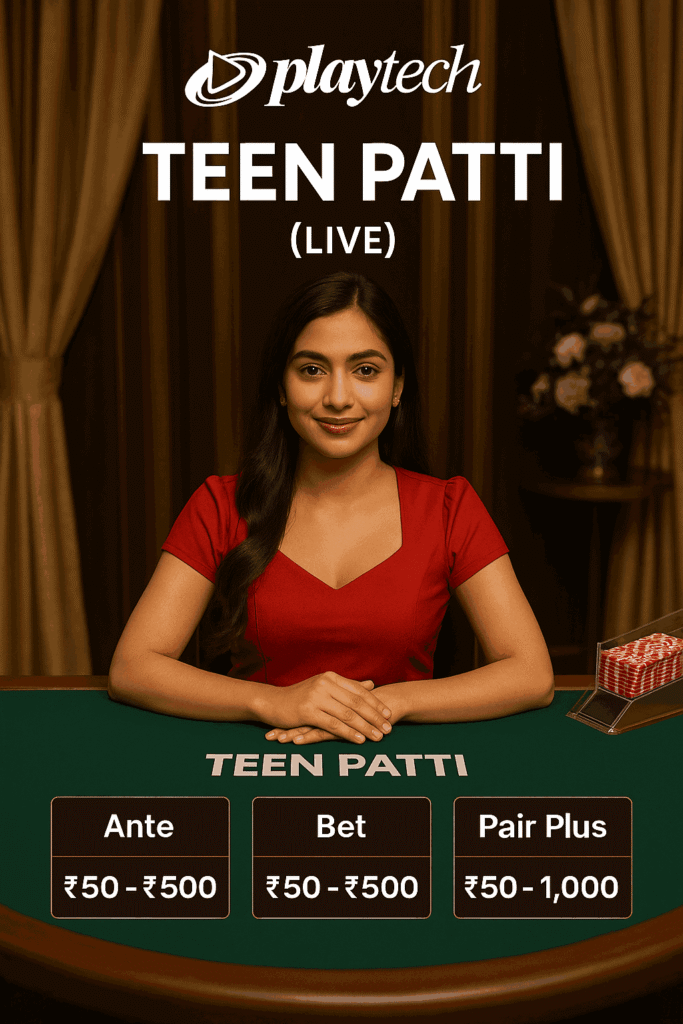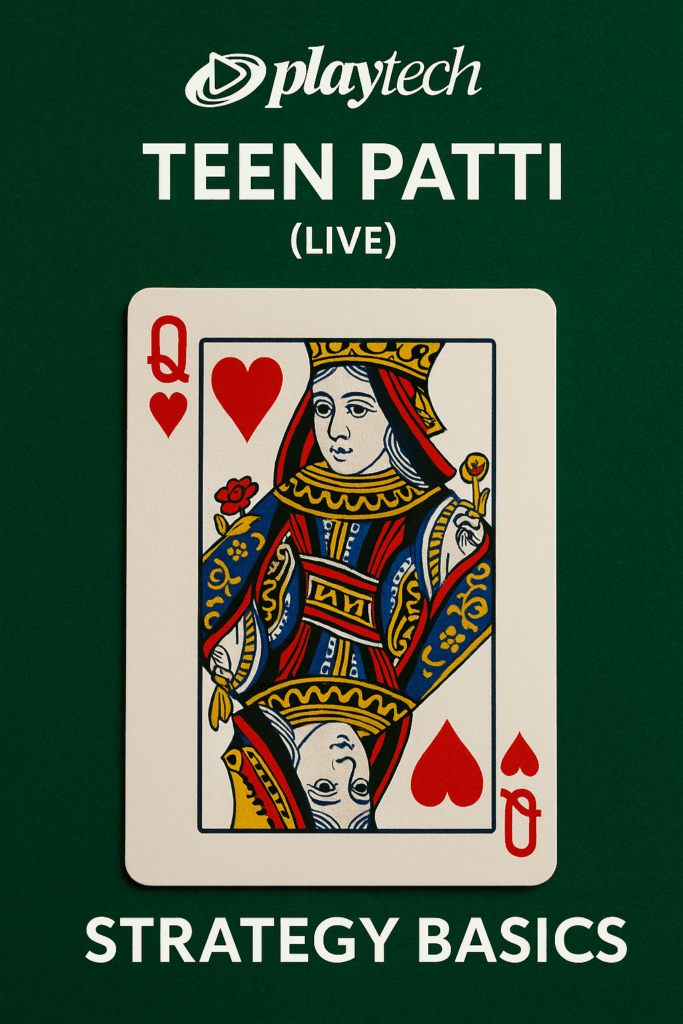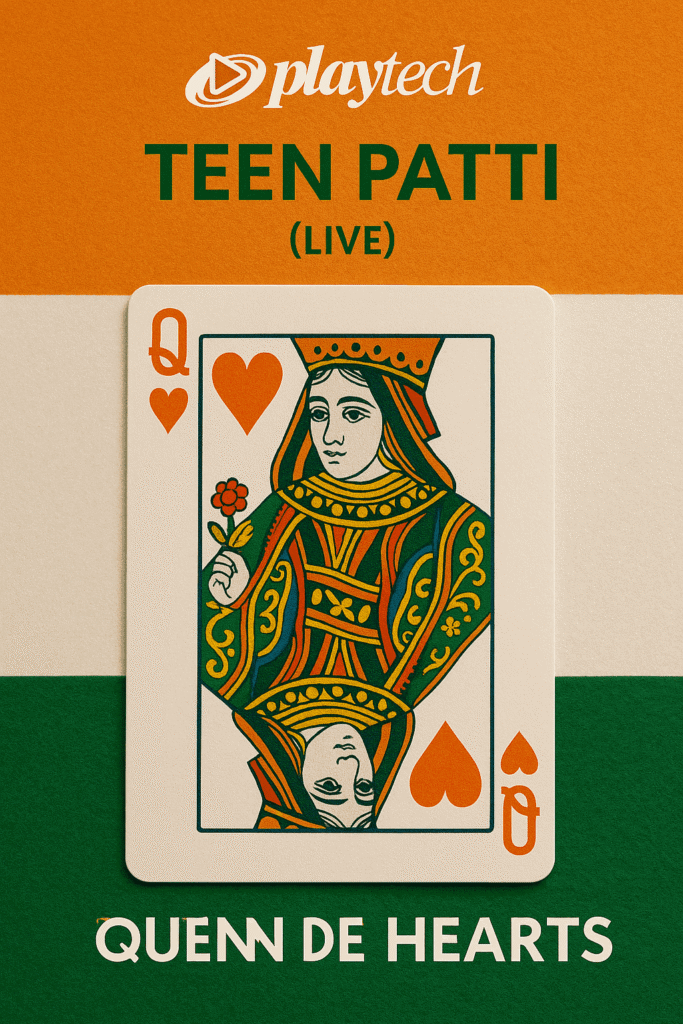What the live game is and how it works
This is a three-card poker-style game dealt from a single 52-card deck. You place an Ante to join the round. After you see your three cards, you either Fold or make a Play bet equal to your Ante. The dealer turns over three cards and compares hands. The dealer must “qualify” with queen-high or better for standard settlement. If the dealer doesn’t qualify, your Ante is paid even money and your Play pushes. If the dealer qualifies and your hand is higher, both Ante and Play are paid even money. If the dealer qualifies and beats you, both Ante and Play lose. Ties push.
Hand ranking uses the usual three-card order where a straight beats a flush (because three-card straights are rarer than three-card flushes). Trips are best, then straight flush, straight, flush, pair, and high card. There is also an Ante Bonus in this version that pays a fixed prize on strong player hands, regardless of what the dealer holds, which slightly improves the main-game return. You’ll also see an optional “blind” way to play (placing bets before you look at your cards). It’s fun but carries lower expected value.

Playtech vs Ezugi – the quick answer
Both studios stream a polished, fast table with Hindi/English speaking hosts and a familiar poker layout. The biggest practical differences sit in the math and the extras. Playtech’s baseline main-game return is higher when you play optimally and factor the Ante Bonus. The blind option exists here, which some players enjoy for pace and surprise, but it trims your long-run return. Ezugi’s core game is closer to classic three-card with no blind feature and a slightly lower main-game return.
Side-bet menus differ. Playtech offers Pairs Plus (pays on pairs or better in your three cards) and Mega Bonus (a larger ladder for premium hands), settled independently of dealer qualification. Ezugi runs Pair or Better for the player hand and a 3+3 Bonus that combines your three cards with the dealer’s three to form a five-card poker hand; it’s volatile and carries a lower theoretical return. If you want steadier, main-game value and optional blind play, choose this table. If you like combo features and higher-variance side bets, Ezugi’s variant scratches that itch. Below you’ll find a detailed, line-by-line comparison to help you pick.
Table layout & interface – where everything is
The layout is simple. Bet spots sit at the bottom center: Ante in the middle, Play lights up after you peek, and two optional circles for side bets. A short betting window gives you time to place and confirm (there’s a clear Confirm button and a Repeat/Double for quick re-entry). A timer bar shows how many seconds remain.
Top left or right you’ll find the table limits label and a chip selector. The settings menu lets you adjust video quality, sound, dealer voice/mix, and animation speed. Rule/help panels outline payouts and hand order. History icons show your recent hands and often the last few dealer qualifications, which is nice for context but shouldn’t be used as a predictor. A lobby button returns you to the live hub without dropping your balance.
On mobile, the same elements compress neatly: chips and Confirm sit above the bet circles, while settings slide out from a simple gear icon. If you prefer autopilot, toggle auto-confirm for quicker rounds, but only after you’re comfortable with the flow.
On-screen controls (example)
| Element | What it does | When to use it | Pro tip |
|---|---|---|---|
| Bet spots (Ante / Play / Pairs Plus / Mega Bonus) | Place your chips for the round | Ante to enter; Play only after seeing cards | Keep side bets optional; don’t auto-add them every hand |
| Confirm / Repeat / Double | Lock bets or re-place last stake | Speeds up consecutive rounds | Use Repeat but glance at limits before you double |
| Timer | Shows time left to act | Plan decisions; avoid last-second clicks | Decide side-bet use before the timer starts |
| Settings (gear) | Video, audio, auto-confirm | Stabilize stream on weaker connections | Drop to a lower resolution for smoother play |
| History / Stats | Recent hands and dealer qualifiers | Review pace and session rhythm | Info only; don’t chase patterns |
| Table limits label | Min/Max stakes for each bet | Pick a table that fits your bankroll | Remember Play must match Ante when you continue |
Stakes & table limits in practice (INR examples)
Limits are set by the operator. Expect a spread of tables to cover low and mid-stakes. As a rule of thumb in India, “low” tables often accept Antes around ₹50-₹200 with maximums that keep total exposure modest. “Standard” tables might start from ₹200-₹500 and cap high enough for regulars. Premium lobbies raise ceilings for bigger Play/Ante stacks.
Remember your Play bet must equal your Ante when you continue, so your real exposure is two units per contested hand, plus any side bets you added. That is why a table that shows ₹200-₹5,000 for Ante may feel like ₹400-₹10,000 in practice once you push Play. Side bets also have their own min and max. Check the “Table Limits” ribbon or the rules panel before you sit, especially on mobile where labels are smaller. If you mostly Fold weaker hands, your average money on the table swings less. If you continue often, pick a lower table so you can ride out qualification pushes and normal variance without stress.
Rules snapshot – the essentials in 60 seconds
One deck. Three cards each. You must Ante to join. You look at your cards, then either Fold (forfeit Ante) or make a Play bet equal to your Ante. Dealer hand stays face down until all decisions are in. The dealer needs queen-high or better to qualify. If the dealer fails to qualify, your Ante pays even money and your Play returns to you. If the dealer qualifies and you win, both Ante and Play pay even money. If the dealer qualifies and beats you, both bets lose. Ties push.
Three-card ranking: trips, straight flush, straight, flush, pair, high card – note that a straight beats a flush here. The Ante Bonus pays a fixed award on strong player hands (for example, a straight or better) whether or not the dealer qualifies, which improves long-run value when you play soundly. Optional side bets settle on their own rules, independent of qualification. The blind feature lets you place bets without peeking first. It adds thrill but reduces expected return compared with optimal open-play decisions.

Side bets here – Pairs Plus & Mega Bonus
Pairs Plus pays if your three cards contain a pair or better. It’s simple, self-contained, and ignores the dealer entirely. Because outcomes are rarer as you climb the ladder, prizes escalate quickly on straights, flushes, trips, and straight flushes. Mega Bonus is a second ladder that focuses on premium results and pays more when you land the very top hands. Both settle right after your cards are revealed and do not care whether the dealer qualifies or beats you.
Two cautions. First, theoretical returns on side bets are lower than the main game, so treat them as entertainment, not a long-term edge. Second, their variance is higher: you’ll see many small losses punctuated by occasional bigger hits. Consider setting a separate, small side-bet budget (for example, 5-10% of your Ante) rather than staking them every hand. If you’re new, play ten or twenty rounds without any side bet to learn pace and decision points. When you add them later, you’ll make clearer, calmer choices and avoid chasing after a cold streak.
RTP & returns
Played with open cards and sound decisions, the main game’s theoretical return is strong, helped by the Ante Bonus paying on top hands even when the dealer doesn’t qualify. That’s why disciplined strategy matters: the closer you stay to optimal decisions, the nearer your results track the published return over time. Pairs Plus and Mega Bonus sit below the main-game return. They’re fine for variety but will not match the long-run efficiency of sticking to Ante/Play fundamentals.
The blind option trims expected value because you sometimes commit Play without the information advantage of seeing your cards. It can be exciting for short sessions, but if your goal is value, you should favor open play. Remember that “RTP” is a long-horizon metric: it’s not your chance to win a hand or a session. Short-term variance is real. Expect stretches of folds, qualification pushes, and alternating wins/losses. Good bankroll rules let you survive that natural ebb and flow so that the math has time to “show up.”
Where you’ll find the game (availability notes)
Availability depends on the operator’s live-casino mix and licensing. Look under “Playtech” in the live lobby or within “Indian games” and “card games” categories. Global brands that carry multiple studios often split Teen Patti supply between providers, so you may see two tiles with similar names. Read the label or open the info panel to confirm which studio you’re joining.
India-facing sites usually mirror the same table structures you see elsewhere: low-entry tables for casual play and mid-ceiling tables for regulars. Peak-time lobbies can be busy, so keep a backup table in mind if your preferred dealer fills up. On mobile, table tiles may only show the minimum; tap the “limits” line inside the table to view the full stake range before placing your first Ante. If you are shopping for welcome offers or live-table promos, check the bonus terms. Some bonuses exclude live poker-style games or contribute at a reduced rate.
Detailed comparison – line by line
The two leading versions feel similar at the table but diverge in a few meaningful ways that affect value and feel. Use this summary to decide which suits your style.
Comparison: key parameters that matter
| Parameter | Playtech version | Ezugi version | Why it matters |
|---|---|---|---|
| Main-game return (optimal play) | Higher, aided by Ante Bonus on top hands | Lower baseline without that same boost | Better value if you play disciplined decisions |
| Side bets | Pairs Plus and Mega Bonus | Pair or Better and 3+3 Bonus | Different volatility and prize ladders |
| Blind play | Available (lower expected value) | Generally not offered | Entertainment vs efficiency |
| Dealer qualification | Queen-high | Queen-high | Drives push/paid outcomes |
| Typical limits | Operator-defined; low and mid tables common | Operator-defined; similar ranges | Match tables to bankroll and pace |
| Feel & pacing | Tight cycles; clear UI for Play/Ante | Stable pacing; extra combo side bet | Choose clarity vs combo variety |
If you want the best long-run value, pick the table with the stronger main game and use side bets sparingly. If you enjoy high-variance side features and don’t mind a lower return, the alternative variant offers that thrill. Your choice should reflect your goals: value, variety, or a mix.
Strategy basics that actually matter
Three simple rules carry most of the weight. First, only continue with decent high-card structure: a common baseline is to play Q-6-4 or better; fold worse. That guideline keeps you from leaking chips with too many weak continuations. Second, keep your Play sizing tight by remembering it must match your Ante. If you raise your Ante to “feel” the action, you double your risk on every continue. Third, treat side bets as optional spice. The main game is where the value sits.
Five quick do’s
- Use Q-6-4 as your default continue point; fold below it.
- Avoid blind play if you care about expected value.
- Keep Ante steady; Play will mirror it by rule.
- If you add side bets, cap them small and occasional.
- Set a session loss limit and stick to it without exceptions.
These habits don’t guarantee profits. They simply reduce avoidable mistakes and let the solid math do its job over time.

Bankroll & limits – converting to INR and table selection
Think in “units.” One unit is your Ante. When you continue, you add another unit as Play. That means a hand you play to showdown costs two units, not one. If your unit is ₹200, a continued hand is ₹400 before any side bet. Plan your table choice with that in mind. If you intend to continue often, pick a lower table so that two-unit hands fit your budget comfortably.
Session length matters. Ten quick hands can produce big swings because of dealer qualification pushes and coin-flip showdowns. Give yourself enough units to survive normal volatility. A common approach is 50-100 units for a longer session, fewer if you’re only sampling a few rounds. If you’re converting from another currency in your head, round conservatively and avoid creeping your stake up mid-session because you “feel due.”
Four bankroll rules of thumb
- Size the Ante so two-unit hands never feel heavy.
- Pre-set a stop-loss and a soft win target.
- Keep side bets to a small fixed fraction of the Ante.
- Pace yourself: short breaks beat tilt decisions.
Common mistakes & myths to avoid
Most slips come from pace and emotion. The game runs quickly, so small leaks add up fast if you’re not deliberate. The history board is context, not a forecast; it can’t predict whether the dealer will qualify next hand. Blind play is a novelty, not a shortcut to value. And “three-card brag” folk wisdom doesn’t always map to this table’s exact payouts and rules. Keep these traps in mind:
Six frequent errors
- Chasing losses by switching to blind after a bad run.
- Auto-adding Pairs Plus every hand without a budget.
- Forgetting that Play must match Ante (doubling risk).
- Treating the stats panel as a predictor.
- Assuming flush beats straight (here, straight is higher).
- “Due” thinking: betting up because qualifiers have been rare.
Sticking to a calm routine and a fixed unit size will prevent most of these from biting you.
Mobile play, stream quality & language tables
On phones, the stream adapts to small screens well. Chip trays and Confirm sit closer to your thumb, and bet circles are large enough for quick taps. If your connection dips, open the gear icon and drop video quality to keep audio and dealing in sync. Auto-confirm speeds things up but don’t enable it until you’re comfortable, because you’ll have less time to catch a mis-click.
Dealers rotate across Hindi and English depending on the hour and the lobby. Language badges on the table tile or in the header help you choose. The betting window is short, so pre-decide your plan for side bets before the timer starts. If you’re multitasking on mobile, consider muting table chat to reduce distractions. Tilt prevention is a feature, too: take a breath, sit out a round, and then return when you’re ready. The rules and payouts are always available in the help panel; reading them once on your device will save you from guessing mid-session.
FAQ
1) What is Playtech Teen Patti and how does it work?
It’s a live three-card poker variant dealt from one 52-card deck. You place an Ante, then either Fold or add a Play bet equal to Ante after seeing your cards. The dealer qualifies on queen-high. If the dealer doesn’t qualify, Ante pays 1:1 and Play pushes; if the dealer qualifies and you win, both pay 1:1; ties push. A built-in Ante Bonus pays on strong player hands regardless of dealer qualification.
2) How is Playtech Teen Patti different from Ezugi/Evolution versions?
Playtech adds an Ante Bonus that lifts the main-game return versus other studios, and it offers Blind play as an extra. Ezugi/Evolution use similar core rules but publish a lower main-game RTP. Typical figures: Playtech main ~97.74% vs ~96.63% on other versions; side-bet menus also differ.
3) What are the RTPs for Playtech Teen Patti (main and side bets)?
With optimal play: Ante ~97.74%. Pairs Plus ~95.80%. Mega Bonus ~95.28%. If you use Blind, overall returns drop to about 95.96%
4) What is the “Blind” option and is it worth using?
Blind lets you commit to Play before seeing cards. It’s there for pace and fun, but the math is worse: ~95.96% long-run return. If you care about value, stick to open play.
5) Are side bets mandatory, and how do Pairs Plus / Mega Bonus settle?
They’re optional. Pairs Plus pays on your three-card hand (pair or better) and can be played even without an Ante bet. Mega Bonus builds a five-card hand from player + dealer cards (pays from trips up), and requires an Ante. Both settle independently of dealer qualification.
6) What’s the basic strategy for beginners?
Use the standard three-card baseline: play Q-6-4 or better; fold worse. It’s simple, keeps leaks down, and aligns you with the published main-game RTP over time.
7) What table limits should I expect, and where do I check them?
Limits are set by each casino. Example public listing shows min £0.50 / max £5 on a low-cap table, and sites often display an RTP range for the lobby. Always open the table info/limits ribbon before you sit, especially on mobile.